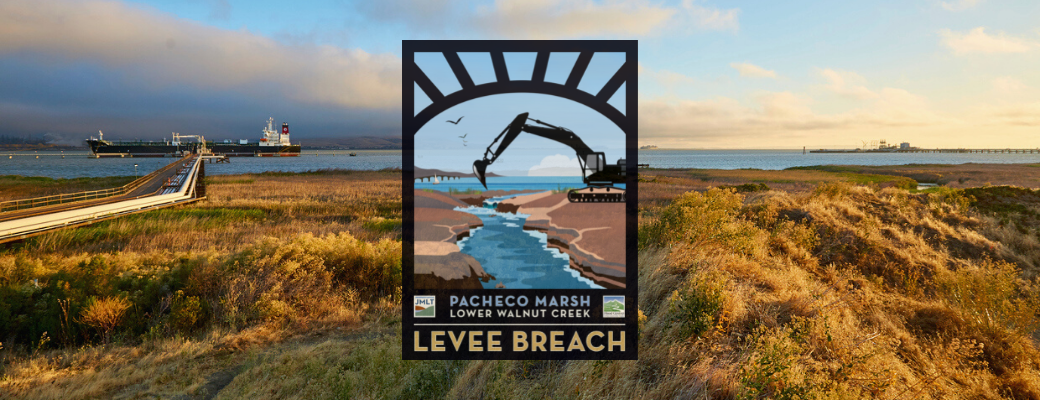Dramatic Levee Breach Is Major Milestone in $24.5 Million Restoration of Pacheco Marsh and Lower Walnut Creek

Weekend Hike: Carr Ranch Loop Trail
September 22, 2021232-acre East Bay tidal marsh restoration complete
October 29, 2021

MEDIA ALERT
Pacheco Marsh Levee Breach
October 29, 2021, 9 am
Location: Pacheco Marsh, 2501 Waterfront Rd, Martinez, CA 94533
Martinez, CA — John Muir Land Trust (JMLT) and Contra Costa County Flood Control & Water Conservation District (CCCFCD) invite the media to observe the dramatic breach of the levee that will allow the waters of Suisun Bay to flow back into 232-acre Pacheco Marsh—a huge step in the restoration of this vital marsh and the Lower Walnut Creek watershed.
News crews, journalists, and photographers will observe this unique event up close.
Principals available for interviews include:
- Linus Eukel, Executive Director of JMLT
- Paul Detjens, Senior Civil Engineer and Lower Walnut Creek Restoration Project Manager, CCCFCD
- Michelle Orr, Wetlands + Estuaries Director, Environmental Science Associates
- Other, Elected officials
The restoration of Pacheco Marsh is part of a broad effort to revitalize the San Francisco Bay shoreline. Generations ago, abundant upstream freshwater marshes and downstream salt marshes supported the health and well-being of marine wildlife. Human activity has resulted in the staggering loss of more than 90% of these historic tidal wetlands. Pacheco Marsh is a microcosm of the larger story. Scarred by industrial activity, Pacheco Marsh has been diked, drained, and partially filled with dredge spoils. The creek has been widened and redirected. A sanitary sewer outfall runs down the middle of the property.
JMLT and CCCFCD are working to restore Pacheco Marsh as a haven for wildlife and open the site to visitors. The levee breach is a dynamic event that marks the completion of two decades of work to acquire the property, raise $24.5 million in funding, and complete the first phases of restoration.
In June, 2021 JMLT successfully raised $1 million from individual donors for the construction of low-impact features to prepare the site to be opened to the public. Destined to be a favorite destination where young people can learn firsthand about the salt marsh ecosystem, the restored marsh will soon welcome all nature lovers to enjoy birdwatching and informative walks along the shore of Suisun Bay.
The unique design of the restoration will allow the marsh to adapt to climate change and rising sea level.
Event schedule:
9:00am – Arrival
9:00am to 10:15 am – Setup at site (1 mile from road)
9:00am to 10:15 am – Interviews
10:30am – Program Begins
11:30am – Levee Breach
11:45am – Interviews
Event logistics:
- Excellent views
- Drone video footage will be available from JMLT drone
- Attendees should wear sturdy shoes, be prepared for cool windy weather and possibility of rain
- Ample parking and easy access
- Transportation to site (1 mile) provided if needed
What is a levee breach?
Simply said, a levee breach is removing the last piece of a levee to let tidal waters into an area that has been previously blocked off from the tides. However, the breach represents much more, as it is the culmination of:
- 7 months of heavy civil construction
- Dozens of biological surveys for special status species
- Hundreds of hours of biological monitoring to locate and protect special status species
- Installation of over 7 miles of protective fence
- Excavation and transport of nearly 35,000 dump truck loads of soil to restore the site to proper marshplain elevation.
- Construction of over 5 miles of new tidal channels
- Construction of 5 marsh ponds to establish new seasonal wetlands
- Construction of 2.6 miles of access roads and trails for future public access
It was necessary to complete this work in dry conditions by constructing a levee. The levee breach removes this ‘plug’ from the tidal channel. The project contractor, 4 M Contracting, will use a large excavator to remove the final few scoops of soil from the mouth of the tidal channel and allow water from the bay to dramatically rush into the project site. Areas that were dry and barren will now benefit from twice daily tidal flows. As the site revegetates over a few months, these barren areas will become green and full of life.
The tidal breach is the final step of a long construction process, and the kick off of the rejuvenation of Pacheco Marsh.
Contacts:
Linus Eukel
Executive Director, John Muir Land Trust
linus@nulljml.org
925-788-7525
Paul Detjens
Senior Civil Engineer, Contra Costa County Flood Control & Water Conservation District
Paul.detjens@nullpw.cccounty.us
925-313-2394
Jay Dean
Creative Strategy Director, John Muir Land Trust
jay@nulljmlt.org
510-590-1077
Funding and support for Pacheco Marsh restoration provided by:
John Muir Land Trust
Contra Costa County Flood Control & Water Conservation District
California Department of Fish and Wildlife
California Climate Investments
California State Coastal Conservancy
State of California Department of Water Resources
Marathon Petroleum
National Fish and Wildlife Foundation
Resources Legacy Fund
San Francisco Bay Restoration Authority
State of California Wildlife Conservation Board
U.S. Fish and Wildlife Service
United States Environmental Protection Agency
About John Muir Land Trust
John Muir Land Trust (JMLT) protects and cares for open space, ranches, farms, parkland and shoreline in Contra Costa and Alameda Counties. In a generation, John Muir Land Trust has become one of the leading forces for conservation in northern California. With 3,500 acres protected, many beautiful places in the East Bay are permanently preserved for recreation, wildlife habitat, and spectacular scenic views. JMLT believes hat the vitality of our open spaces is essential to the health of our earth, air, water, native plants, and animals—and all of us. jmlt.org
About Contra Costa County Flood Control District
The Contra Costa County Flood Control and Water Conservation District works to reduce flood risk, promote stormwater quality, and restore and enhance natural resources in watersheds throughout Contra Costa County. Formed in 1951 in response to rapid urbanization, the District has partnered with state and federal entities to deliver over $1.3B in stormwater infrastructure that protects $34B of community assets from flooding. The District’s portfolio contains nearly 80 miles of streams, 24 detention basins, and 5 dams.
Over the decades, the District’s role has evolved from single-purpose infrastructure delivery to being a leading steward of streams throughout Contra Costa County and delivering multi-benefit projects such as Lower Walnut Creek Restoration. The District manages its own assets and partners with non-profit organizations to broaden its positive reach.
The District is proudly celebrating its 70th Anniversary in 2021. www.cccounty.us/floodcontrol
About Lower Walnut Creek Restoration and the Pacheco Marsh Restoration and Public Access Project
- Overall Project Goal: $24.5 million
- Restoration: $19.5 million
- Public Access: $5 million
The FC District has raised $16.4m from nine grantors to implement restoration grading and revegetation work. In June 2021, JMLT raised $1 million to provide for public access at Pacheco Marsh. Features will include 2.4 miles of trails, elevated vistas, bird blinds, a kayak launch, and an educational facility.
Recovering A Vital Ecosystem
Generations ago, the San Francisco Bay and Delta supported abundant upstream freshwater marshes and downstream salt marshes and mudflats. These served as vital pathways for migrating birds and fish species that spawn in inland streams and live adult lives in the ocean. Salt marshes provide essential food, nutrients, refuge, and nursery habitat for an estimated 75 percent of fisheries species. Human activity has resulted in the loss of more than 90% of historic tidal wetlands. Pacheco Marsh has been diked, drained, and partially filled with dredge spoils. The creek has been widened and redirected. A sanitary sewer outfall has been built down the middle of the property. Scarred by this industrial activity, Pacheco Marsh is a microcosm of the larger story.
Thriving Habitat
The project establishes habitat for threatened bird species, marine invertebrates, and coastal fish. Pacheco Marsh is home to ten special- status plant and animal species, including the salt-marsh harvest mouse and the Black Rail—rarely-seen and on the list of avid birdwatchers. Nutrients and biological connectivity are being restored through soil quality rehabilitation and lowering of the levee. When the site opens, visitors will experience abundant wildlife thriving side-by-side with human communities. The site is known as a birders’ paradise.
Outdoor Classroom
Unique educational features will teach young people how a marsh ecosystem functions and why it is so important to life in the Bay. Planned are 2.4 miles of walking trails, elevated vistas, bird blinds, interpretive signs, and an educational facility. The marsh will teach how human activity can harm the natural environment, but also how responsible care and attention can catalyze nature’s remarkable ability to recover.
Natural Solutions for Community Needs
Salt marshes protect shorelines from erosion by buffering wave action and trapping sediments. Marshes protect water quality by filtering runoff and metabolizing excess nutrients. Marshes protect community infrastructure during periods of intense flooding. Thoughtful design strengthens ecological resilience by allowing the marsh to adapt over time to climate change and sea level rise.
Recreation
With planned low-impact features in place, bird watchers and outdoor enthusiasts will soon view wildlife responsibly in restored habitat. Those seeking healthy recreation will explore carefully constructed trails that offer up-close views of each sub-ecosystem while protecting the marsh’s full-time residents. Young minds will experience nature firsthand. All will be enthralled by the stunning contrasts—thriving habitat surrounded by a stark industrial backdrop. The towers of oil refineries can be seen in the distance while tankers pass underneath the parallel spans of the Benicia-Martinez Bridge to the north. The entire history of the shoreline can be experienced in this one remarkable place.
Media assets for download:
Pacheco Marsh restoration photos (Credit: Adam Weidenbach)
Pacheco Marsh Levee Breach event program

